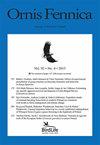Diet shifting of tortoise-eating Golden Eagles (Aquila chrysaetos) in southeastern Bulgaria
IF 1.2
4区 生物学
Q2 ORNITHOLOGY
引用次数: 5
Abstract
Top predators may adapt their diets to changes in prey availability where human-induced environmental changes are intense. This long-term study of the breeding-season diet of Golden Eagle (Aquila chrysaetos) in the Strandzha Mountains analyzed shifts in diet caused by the population decline in principal prey species, the tortoises (Testudo hermanni and T. graeca). Tortoises comprised 50.0% of the eagle diet by prey number in the 1990s, but that share collapsed to 5.8% in 2014–2021. During this later interval, Golden Eagles preyed more intensively on lighter-weight prey such as Northern White-breasted Hedgehog (Erinaceus roumanicus, an increrase of 28.2% by number) and Edible Dormouse (Glis glis, an increase of 14.9% by number). Hedgehogs predominated in the diet of an individual eagle nest site for the first time in 1998 and became the principal prey in 2014–2021. Differences in food niche breadth and proportions of mesopredators between tortoise- and hedgehog-dominated individual annual diets were not significant, corresponding to a low level of food stress. The only eagle with an annual diet dominated by Squamata (snakes and lizards) was an exception, having the widest food niche. Young domestic ungulates have almost completely disappeared from eagle diets at the same as the reduction of tortoises, corresponding to a concurrent decline of livestock farming. The results obtained here have relevance to conservation management of both predator and prey populations.保加利亚东南部以龟为食的金雕的饮食变化
在人类引起的环境剧烈变化的地方,顶级捕食者可能会调整自己的饮食以适应猎物数量的变化。这项对斯特兰扎山脉金鹰(Aquila chrysaetos)繁殖季节饮食的长期研究分析了主要猎物物种龟(Testudo hermanni和T. graeca)数量下降导致的饮食变化。在20世纪90年代,乌龟占鹰饮食的50.0%,但在2014-2021年,这一比例下降到5.8%。在这一后期,金雕更集中地捕食较轻的猎物,如北方白胸刺猬(Erinaceus roumanicus,数量增加了28.2%)和食用睡鼠(Glis Glis,数量增加了14.9%)。1998年,刺猬首次在单个鹰巢的饮食中占主导地位,并在2014-2021年成为主要猎物。以龟和刺猬为主导的个体年食性在食物生态位宽度和中捕食者比例上的差异不显著,对应于低水平的食物应激。唯一一种以鳞目动物(蛇和蜥蜴)为主要食物的鹰是个例外,它有最广泛的食物生态位。幼小的家养有蹄类动物几乎完全从鹰的饮食中消失了,与此同时,陆龟的数量也在减少,这与畜牧业的同时减少相对应。本研究结果对捕食者和猎物种群的保护管理具有重要意义。
本文章由计算机程序翻译,如有差异,请以英文原文为准。
求助全文
约1分钟内获得全文
求助全文
来源期刊

Ornis Fennica
生物-鸟类学
CiteScore
2.00
自引率
0.00%
发文量
14
审稿时长
>12 weeks
期刊介绍:
Ornis Fennica is a peer-reviewed international ornithological journal published by BirdLife Finland. Ornis Fennica publishes analytical and experimental papers on the ecology, behaviour and biogeography of birds. Ornis Fennica prefers studies concerning Fennoscandian species, but other novel contributions of general interest are most welcome as well.
Ornis Fennica is an open-access journal without page charges for publication. All published articles (from 1924 onwards) are freely available from the journal website. First decisions are usually made within three months of submission.
 求助内容:
求助内容: 应助结果提醒方式:
应助结果提醒方式:


